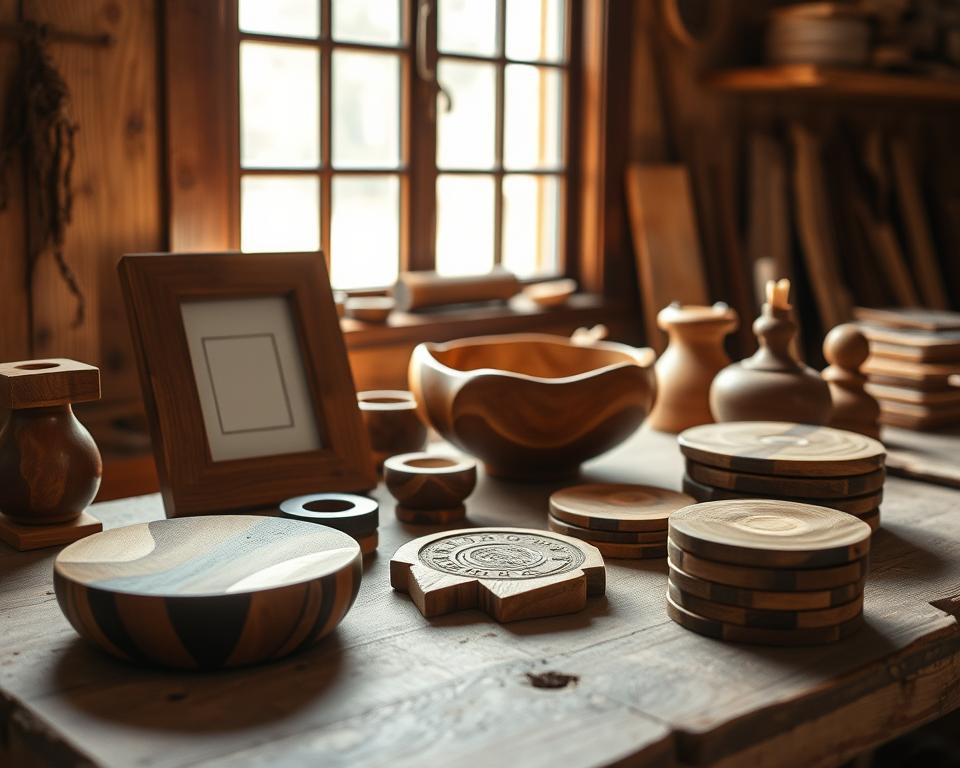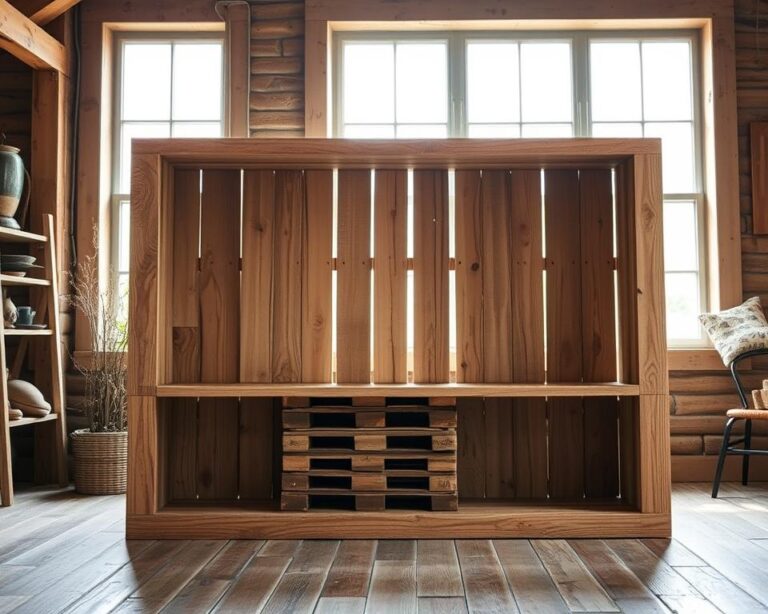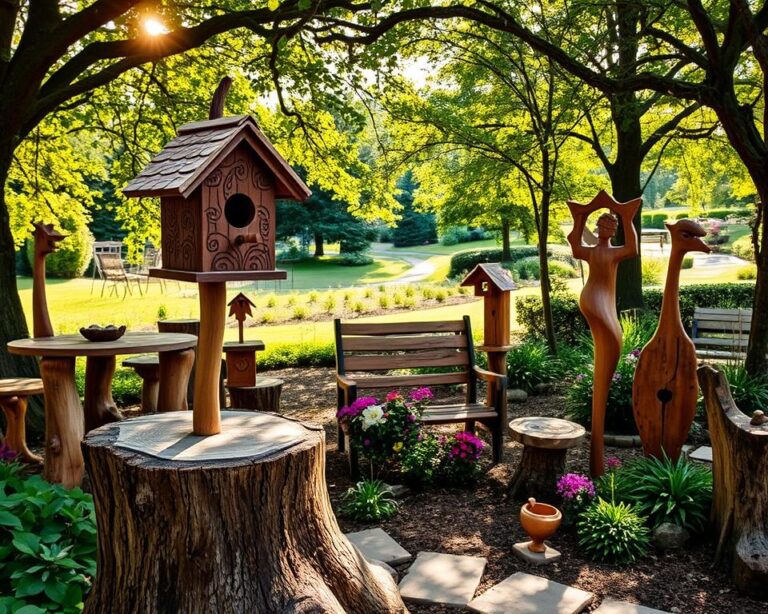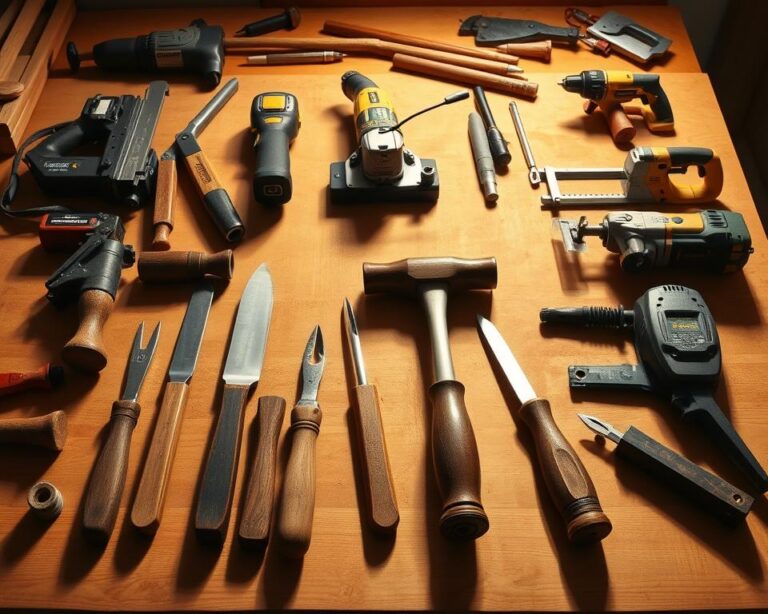Did you know the global market for handmade goods was worth $38.2 billion in 2022? It’s expected to grow by 10% every year. This shows the huge potential for selling woodcrafts online. If you love woodworking, you can turn your hobby into a profitable side business.
You don’t need years of experience to begin. There are many woodworking projects for all skill levels. We’ll show you how to start your woodworking business online. You’ll learn about choosing projects and marketing them.
Getting Started with Woodcrafting
Starting your woodcrafting journey is both exciting and rewarding. It’s important to pick woodworking projects that match your interests and what’s popular. You might enjoy making wooden signs, furniture, or items from repurposed pallets.
Having the right tools makes crafting easier and more fun. Knowing about different wood types can help you create unique and durable pieces. This adds beauty to your projects.
Choosing the Right Projects
When picking woodworking projects, consider a few things:
- Personal interest: Pick projects that you find exciting.
- Skill level: Start with simple projects and move to more complex ones as you get better.
- Market demand: Look at what’s popular to make sure your woodwork will sell well.
Essential Tools You’ll Need
A good workshop makes crafting easier. You’ll need:
- Saws (hand saws or power saws)
- Drills for making holes
- Measuring tapes and squares for accuracy
- Clamps to hold pieces together
- Wood glue for joining pieces
Understanding Wood Types
The wood you choose affects your project’s outcome. Here are some common types:
| Wood Type | Characteristics | Best Uses |
|---|---|---|
| Oak | Strong and durable, with a prominent grain | Furniture, flooring, cabinetry |
| Pine | Lightweight and easy to work with, but less durable | Beginner projects, crafts, children’s furniture |
| Walnut | Rich color and intricate grain patterns | High-end furniture and artisan pieces |
Setting Up Your Workspace
Creating an efficient workspace is key to your woodworking journey. A well-organized area boosts productivity and sparks creativity. With careful planning, you can turn your space into a haven for your custom woodworking crafts.
Organizing Your Tools
Efficient tool organization is crucial for smooth projects. Start by grouping your tools, like cutting, measuring, and finishing. Use labeled storage boxes or pegboards to keep everything within reach.
When working with reclaimed barn wood or other rustic wood creations, having the right tools easily accessible can significantly enhance your workflow.
Safety Tips for Woodworking
Safety is essential when working on your projects. Always wear cut-resistant gloves to protect against splinters. An N95 mask is advisable during sanding, as it prevents inhalation of wood dust.
Regularly check your tools for any wear and tear, ensuring they function properly. For more in-depth safety practices, consider visiting this resource to enhance your workspace safety strategy.
Creating Quality Woodcrafts
Creating personalized wood gifts that stand out is all about quality craftsmanship. Each piece made with care shows your dedication to woodwork. This way, the unique qualities of each wood type shine, making your products special.
Craftsmanship vs. Mass Production
Artisan woodwork is loved by those who value authenticity. Mass production focuses on speed, not quality, leading to products without a personal touch. On the other hand, craftsmanship brings out the unique character of each piece, something customers love.
Adding Personal Touches
Adding personal touches to your work makes it special. Options like custom engravings or unique finishes are a hit. These details not only look great but also create a strong bond with the buyer.
Importance of Finishing
A good finishing process is key for durability and looks. Techniques like sanding, staining, and protective coatings make your woodwork better. A polished finish shows off your skill and ensures your product lasts long.
| Finishing Technique | Benefits | Best Use Cases |
|---|---|---|
| Sanding | Prepares wood, smoothing imperfections | Before staining or painting |
| Staining | Enhances grain and color of wood | Decorative pieces and furniture |
| Varnishing | Protects against moisture and wear | Outdoor items and high-use surfaces |
Pricing Your Wood Projects
Setting the right price for your woodworking projects is key to attracting customers and making sales. A good pricing strategy looks at material costs, labor, and market trends. This way, you can sell your projects competitively and still make a profit.
Cost of Materials and Labor
It’s important to know the costs of your custom woodworking crafts. Start by listing the materials you use, like wood, hardware, and finishes. Labor costs should include the time and skill you put into each piece. Make a detailed budget for each project to cover all costs.
Researching Competitor Prices
Take time to check out what other artisans charge for similar items. Look at prices in online marketplaces and compare them. This helps you understand what to charge and can inspire you to improve your offerings. Remember, your unique skills and designs might mean you can charge more.
Understanding Your Market
Knowing what your target market likes is crucial. Customers are willing to pay differently based on what they think your items are worth. Do surveys or ask for feedback to learn more. Adjust your prices to meet your audience’s needs while keeping your projects valuable. This balance can lead to loyal customers and business growth.
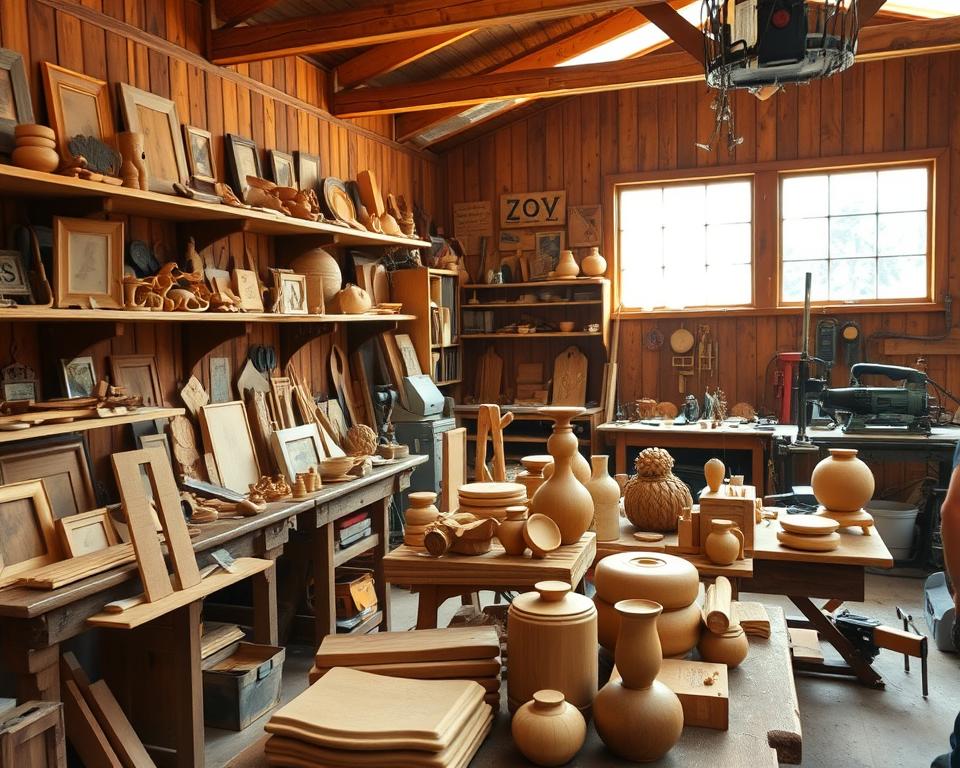
Taking Great Product Photos
High-quality images are key to selling artisan woodwork online. You need to focus on lighting, angles, and editing. This ensures your wood products grab the attention of potential buyers.
Lighting and Background Tips
Natural light is best for photos. Try to take pictures during the day. Place your items near a window or outside, avoiding harsh sunlight.
Choose simple, neutral backgrounds. A white or light-colored backdrop makes wood textures and grains pop.
Angles That Sell
Try different angles to show off your woodwork. A straight shot shows the design, while a tilt or close-up highlights details. Show your product from all sides.
Buyers like to see all angles before buying. It helps them feel confident in their purchase.
Editing Your Photos
Editing is important for great photos. Use software to tweak brightness, contrast, and colors. Crop out anything not needed to focus on your woodwork.
A well-edited photo looks professional. It builds trust with buyers looking for unique wood products.
Building Your Online Presence
Having a strong online presence is key to selling your woodcrafts well. Choose the right platform, set up a great profile, and write catchy descriptions. This way, you can draw in the right people for your handmade wooden items.
Choosing the Right Platform
Platforms like Etsy and Shopify are great for selling your custom woodworking crafts. Look at their user interfaces, fees, and who they attract. The right platform can really help your sales and visibility.
Setting Up Your Profile
Your profile is your first chance to impress buyers. Show your love for woodcrafts and your skill. Use a professional photo, write a compelling bio, and make sure your contact info is easy to find.
Writing Effective Descriptions
Descriptions are key to grabbing customers’ attention. Talk up the special qualities of your handmade items and their craftsmanship. Explain how they can make someone’s life or home better. Use keywords wisely to help people find you.

Marketing Your Woodcrafts
Marketing your woodwork well is key to reaching your audience. Use different platforms and communities to boost your visibility. This way, you can build a loyal customer base by sparking interest in your rustic wood creations and unique wood products.
Utilizing Social Media
Social media is a great place to show off your wood products. Post eye-catching photos of your rustic wood items and talk to your followers. By posting often and replying to comments, you create a sense of community. This makes people more likely to buy your artisan woodwork.
Joining Craft Communities
Being part of craft communities offers great support and networking chances. There are online spaces for woodworkers at all levels, where you can share knowledge and stories. Building connections in these groups can lead to new projects and more people seeing your work.
Collaborating with Influencers
Working with influencers who match your brand can grow your audience fast. They have a following, which means their support of your work is very valuable. Look for both local and niche influencers to reach the right people with your rustic wood creations.
Shipping and Handling
When you sell your customized woodworking crafts, knowing how to ship them is crucial. Good packaging, fair shipping prices, and a clear returns policy are key. They all help keep your customers happy and your business growing.
Shipping your handcrafted wooden goods with care shows you value them. It also makes your rustic wood creations seem more valuable to buyers.
Packaging Your Products
Good packaging means your projects will arrive safely. Here are some tips:
- Sturdy boxes that can handle rough handling.
- Bubble wrap or packing peanuts for extra protection.
- Fragile stickers to warn handlers.
Showing you care about how your products are packaged speaks volumes about your brand. It shows your commitment to quality.
Calculating Shipping Costs
Getting shipping costs right is important for keeping your prices competitive and profitable. Think about:
- The weight and size of your package.
- The distance to the destination and your shipping options.
- Insurance for valuable items.
Using shipping calculators from carriers can give you quick estimates. This helps you set your prices wisely.
Managing Returns
A clear returns policy builds trust with your customers. You might want to include:
- A specific return window, like 30 days.
- Rules for when returns are accepted, focusing on items in good condition.
- A clear process for handling exchanges or refunds.
Being upfront about returns can improve your relationship with customers. It encourages them to buy from you again and share good experiences with others.
| Shipping Component | Considerations | Best Practices |
|---|---|---|
| Packaging | Materials that protect items | Use double-walled boxes, bubble wrap |
| Shipping Costs | Comprehensive calculations | Use weight and dimension-based quotes |
| Returns Policy | Clear and concise terms | Include conditions and procedures |
Customer Engagement
Engaging with your customers is key to a successful woodworking business. It builds loyalty and boosts your reputation. By quickly answering questions and keeping communication open, you make buyers feel welcome.
Communicating with Buyers
Clear talk with buyers makes their shopping better. Always be honest and open. Use email or social media to update customers, share new items, and solve problems.
Great customer service builds trust and encourages more buys.
Gathering Feedback
Getting feedback after a sale is very important. Send emails to check if buyers are happy with your wood products. Use their feedback to make your products better and more appealing.
Regular feedback helps you meet customer needs and improve your sales.
Building a Loyalty Program
A good loyalty program keeps customers coming back. Offer special discounts, early access to new items, or rewards for buying often. This makes customers feel valued and more likely to choose you over others.
Scaling Your Woodcraft Business
Once your woodcraft business is up and running, think about how to grow it. Look for ways to offer more products to attract more customers and increase sales. This part talks about expanding your product line and finding wholesale opportunities. It also stresses the need for long-term goals to guide your business forward.
Expanding Your Product Line
Adding more custom woodworking crafts can open up new markets. For example, if you make unique wooden toys, you could also make puzzles, educational tools, or kids’ furniture. Each new item brings in more variety and meets different customer needs, helping your business grow in various areas.
Exploring Wholesale Opportunities
Wholesale partnerships can help your artisan woodwork business grow and provide a steady income. Local shops, schools, and toy stores might want to sell your products. By offering good prices and keeping quality high, you can build strong relationships. This expands your customer base and boosts your brand’s visibility.
Setting Long-Term Goals
Setting clear goals is key for long-term success. Decide what success means for your business in the next few years. Think about growing your product range, increasing production, or entering new markets. Having these goals keeps you focused and motivated as you face the challenges of growing your custom woodworking business.
Legal Considerations
Starting your own business selling handcrafted wooden goods requires understanding the legal side. Registering your woodcraft business correctly is key for smooth operations. Whether you plan to sell personalized wood gifts or unique wood products, setting up your business right is crucial.
Business Registration in Canada
In Canada, you must register your business name and choose a legal structure. This could be a sole proprietorship, partnership, or corporation. Registering your business legitimates your operations and lets you open a business bank account. This makes managing your finances easier.
Understanding Taxes
Knowing your tax obligations is vital for your woodcraft business. Learn about sales tax and income tax for your handcrafted wooden goods. Not following these rules can lead to penalties. Keeping detailed records of sales helps you report taxes correctly, keeping your business running smoothly.
Insurance for Your Woodcraft Business
Insurance is often overlooked but is very important. It protects your assets. Consider getting liability insurance to cover claims related to your products. This protection lets you focus on creating and engaging with customers.

